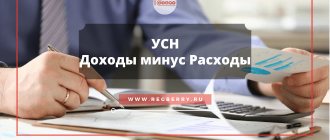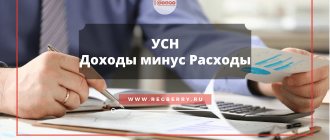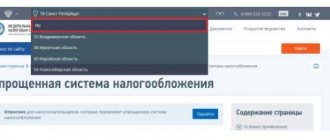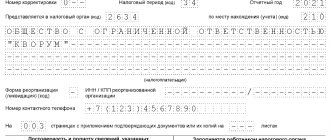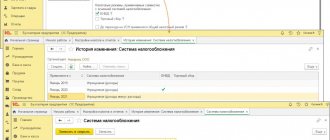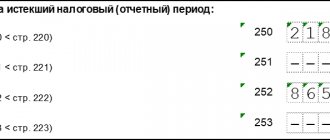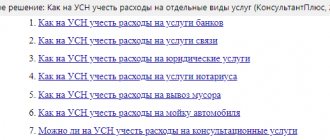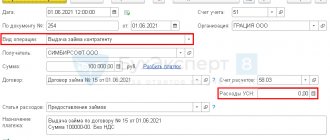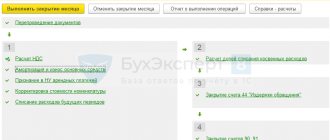USN, OSNO, PSN, NPD, Unified Agricultural Tax: for some this is a meaningless set of letters, but for an entrepreneur it is a direct indication of what his tax burden will be. To learn how you can compare taxation systems in order to legally reduce payments to the budget when doing business, read the article “Taxation systems: how to make the right choice?”
And for those who still have questions or those who want to get advice from a professional, we can offer a free consultation on taxation from 1C specialists:
Free tax consultation
In our service, you can prepare a notification about the transition to the simplified tax system absolutely free of charge. Income minus expenses (relevant for 2022):
Create an application for the simplified tax system for free
You can find out the general provisions of the simplified tax system, relating to both the Income simplified taxation system and the Income minus expenses simplified tax system option, in the article Simplified Taxation System 2022: all about the pros and cons of the simplified tax system with examples.
This article is devoted only to the specifics of the simplified tax system with the tax object “Income minus expenses”.
How to calculate the amount of tax on the simplified tax system Income minus expenses?
Tax rate for the simplified tax system Income minus Expenses
Documentation
Form for notification of transition to the simplified tax system
Notification of transition to the simplified tax system (LLC)
Notification of transition to simplified tax system (IP)
The big advantage of this version of the simplified tax system is the so-called differentiated tax rate. In fact, this is an additional privilege within the already preferential regime. The usual rate of the simplified tax system Income minus expenses is 15%, regional authorities can reduce it to 5%.
A reduced tax rate is not available in all regions, but many constituent entities of the Russian Federation take advantage of this opportunity, attracting additional investments, developing certain types of activities, or solving employment issues.
Laws on differentiated tax rates of the simplified tax system Income minus Expenses are adopted at the local level annually, before the beginning of the year when they come into force. You can find out what rate will be set in the region you are interested in from the territorial tax office or local administration.
We draw the attention of all LLCs to the simplified tax system: Income minus expenses - organizations can pay taxes only by non-cash transfer. This is a requirement of Art. 45 of the Tax Code of the Russian Federation, according to which the organization’s obligation to pay tax is considered fulfilled only after presentation of a payment order to the bank. The Ministry of Finance prohibits paying LLC taxes in cash. We recommend that you open a current account on favorable terms.
Rates from 5% to 15% apply if the usual limits of the simplified tax system are observed (in 2022 this is 164.4 million rubles of annual income and 100 employees). If the number of employees is from 101 to 130 people, and the income is from 164.4 to 219.2 million rubles, then an increased rate of 20% is applied.
Comments
Sergey 04/13/2016 at 10:21 am # Reply
What to do?
Registered an individual entrepreneur on 01/28/16, bought a vending machine (snack) 160 thousand rubles + 10 thousand delivery. Paid rent 2.5 thousand rubles. I bought 30 thousand products. Installed it on 03/04/16. After working for the month of March, on 03/31/16 I made a profit of 12 thousand rubles. 202,500 rubles expenses, 12 thousand income. How to fill out a declaration??? or submit a “zero return?”
Natalia 07/08/2016 at 08:41 # Reply
Sergey, the simplified taxation system declaration is submitted once a year, based on the results of the previous year, until April 30 of the next year. Those. You will submit a declaration in 2022, for 2016. If there is income, then this is no longer a zero declaration, but a regular one. Don’t forget to pay your contributions to the Pension Fund and the Federal Compulsory Medical Insurance Fund. They are paid regardless of whether you have a profit or not.
Tax base for the simplified tax system Income minus Expenses
Of course, when you first get acquainted with the simplified tax system Income minus Expenses, you may get the impression that a more profitable taxation system in the Russian Federation simply does not exist (subject to the minimum possible rate of 5%). However, it is necessary to analyze the possibility of using this version of the simplified tax system in your particular case not only arithmetically.
If everything is quite clear with the tax rate of this regime, then with the other element of taxation, i.e. tax base, a lot of questions arise. Unlike the simplified tax system for Income, where the tax base consists only of income received, the tax base for the simplified tax system for Income minus Expenses is income reduced by the amount of expenses, and to calculate it, it is necessary to correctly confirm the expenses incurred.
Prepare a simplified taxation system declaration online
At its core, the calculation of the single tax on the simplified tax system Income minus expenses is much closer to the calculation of income tax than to the version of the simplified tax system Income. It is no coincidence that Chapter 26.2 of the Tax Code of the Russian Federation, dedicated to the application of the simplified system, several times refers to the provisions governing the calculation of income tax.
The main risk for the taxpayer here is that the tax inspectorate does not recognize the expenses declared in his return under the simplified tax system. If the tax authorities do not agree with the formation of the tax base, then in addition to arrears, i.e. additional tax assessment, a penalty will be calculated and a fine will be imposed under Art. 122 Tax Code (20% of the unpaid tax amount).
✐ Example ▼
In the declaration under the simplified tax system, Dolphin LLC declared income received in the amount of 2,876,634 rubles. and expenses incurred in the amount of RUB 2,246,504. The tax base, according to the taxpayer, amounted to 630,130 rubles, and the amount of tax at a rate of 15% is 94,520 rubles.
Accounting for expenses incurred was carried out according to KUDiR data, and copies of documents confirming the fact of business transactions and payment of expenses were attached to the declaration, at the request of the tax authority. The expenses include (in rubles):
- purchase of raw materials and supplies – 743,000
- purchase of goods intended for resale – 953,000
- salary and insurance premiums for compulsory insurance – 231,504
- office rent – 96,000
- rental of industrial premises – 127,000
- third party accounting services – 53,000
- communication services – 17,000
- office refrigerator – 26,000.
Based on the results of a desk audit of the declaration, the tax inspectorate accepted the following expenses to reduce the tax base:
- purchase of raw materials and materials - 600,000, because materials worth RUB 143,000. were not accepted from the supplier
- purchase of goods intended for resale – 753,000, because not all purchased goods were sold to the buyer
- salary and insurance premiums for compulsory insurance – 231,504
- office rent – 96,000
- rental of industrial premises – 127,000
- communication services – 17,000.
The cost of purchasing a refrigerator for the office in the amount of 26,000 rubles. were not accepted as not related to the business activities of the organization. Also, the costs of third-party accounting services in the amount of 53,000 rubles were considered economically unjustified, because there was a sufficiently qualified accountant on staff whose responsibilities included full accounting services for the organization. In total, expenses were recognized in the amount of 1,824,504 rubles, the tax base was 1,052,130 rubles, and the amount of tax payable was 157,819 rubles.
Tax arrears were accrued in the amount of RUB 63,299. and a fine under Art. Tax Code of the Russian Federation (incomplete payment of tax amounts as a result of understatement of the tax base), in the amount of 20% of the unpaid tax amount, i.e. RUB 12,660
Note: to this amount it is also necessary to add penalties for late payment of under-accrued amounts of advance payments, which will require indicating income and expenses quarterly.
Simplified tax system calculator
Let me give you an example:
For the year, the individual entrepreneur M.I. Kroshkin, working on the simplified tax system of 15%, had a total income for the year of 2,650,000 rubles, expenses amounted to 2,890,000 rubles. That is, expenses exceeded income. It would be logical to assume that at the end of the year, IP Kroshkin M.I. does not have to pay tax to the simplified tax system.
However, in this situation there is a need to apply a minimum tax of the simplified tax system, amounting to 1% of total income. That is, Kroshkin M.I. will pay 26,500 rubles.
A situation may arise in which, based on the results of a quarter or half a year, income exceeded expenses, which means that the entrepreneur had to pay in advance based on the results of the quarter and half a year. At the end of the year, this paid amount will need to be subtracted from the calculations obtained by recalculating the entire annual income multiplied by 1%. That is, payments for the year, taking into account advance payments made for the quarter and half-year, will amount to 1% of income.
Accounting for income using the simplified tax system Income minus Expenses
The definition of income for this regime is no different from the definition of income for the simplified tax system Income. In turn, Art. 346.15 of the Tax Code of the Russian Federation, which regulates the procedure for determining income in a simplified system, refers to the provisions of Chapter 25 of the Tax Code of the Russian Federation on income tax.
So, the income taken into account for calculating the tax base on the simplified tax system Income minus Expenses is recognized as income from sales and some non-operating income.
Sales income includes:
- revenue from sales of own-produced products, works and services;
- revenue from the sale of previously purchased goods;
- proceeds from the sale of property rights.
Important: the amounts of proceeds from sales also include the amounts of advances and prepayments received for upcoming deliveries of goods, provision of services and performance of work.
Non-operating income includes income that is not income from sales specified in Art. 250 Tax Code of the Russian Federation. In particular, these include:
- property, work, services or property rights received free of charge;
- amounts of fines, penalties and other sanctions for violation by a partner of contractual terms, if they are recognized as a debtor or are subject to payment based on a court decision;
- income in the form of interest on loans and borrowings provided by the company;
- income from equity participation in other organizations;
- income from the rental or sublease of property;
- income from participation in a simple partnership;
- amounts of written off accounts payable, etc.
Income is recorded or recognized for the simplified tax system using the cash method. This means that the date of recognition of income is the date of receipt of money in the cash register or bank account, as well as the date of receipt of property and property rights, provision of services and performance of work. Amounts of income must be reflected in the book of income and expenses (KUDiR) on the date on which they were received.
Accounting for expenses on the simplified tax system Income minus Expenses
To recognize expenses when calculating the tax base, taxpayers who have chosen this option of the simplified tax system must meet the following conditions:
1. Expenses must be included in the list given in Art. 346.16 Tax Code of the Russian Federation.
Among them:
- expenses for the acquisition of fixed assets and intangible assets;
- expenses for repair and reconstruction of fixed assets;
- expenses for wages, business trips and compulsory insurance of employees;
- rental, leasing, import customs payments;
- material costs;
- expenses for accounting, auditing, notary and legal services;
- the amount of taxes and fees, except for the single tax on the simplified tax system;
- expenses for the purchase of goods intended for resale;
- transportation costs, etc.
The list of expenses is closed, i.e. does not allow the recognition of other types of expenses not specified in the list.
Important: quarterly advance payments cannot be taken into account in expenses when forming the tax base for the simplified tax system Income minus expenses. These payments can only reduce the amount of tax at the end of the year, calculated in the declaration under the simplified tax system.
2. Expenses must be economically justified and documented.
Economically justified expenses mean those expenses that are aimed at making a profit, i.e. have a clear business purpose. Here you need to be prepared to explain to the tax authorities the need for those expenses, the connection of which with a business purpose is not clearly visible. For example, why a computer with bells and whistles was purchased for the office, and not a regular one, or how a luxury company car can be associated with the formation of a circle of elite clients.
As an argument in tax disputes, you can use the legal position of the Constitutional Court of the Russian Federation, expressed in Determination No. 320-O-P of 06/04/07. In this document, the Constitutional Court recognizes that expenses that were aimed at making a profit from business activities can be recognized as economically justified, even if this result was not achieved.
However, a taxpayer can spend his money without the approval of the Federal Tax Service, but in order to take these expenses into account when forming the tax base for the simplified tax system Income minus expenses, one will have to take into account the factor of the supervisory authorities’ suspicious attitude towards business. Unfortunately, the presumption of good faith of the taxpayer, approved by Art. 3 of the Tax Code of the Russian Federation and Art. 10 of the Civil Code of the Russian Federation, works little in practice.
As for documenting expenses for the simplified tax system, you must have at least two documents to confirm each expense. One of them must prove the fact of a business transaction (consignment note or acceptance certificate), and the second confirms payment of the expense. For non-cash payments, the expense is confirmed by a payment order, account statement, receipt, and for cash payments - with a cash receipt. Documents that confirm the expenses incurred for the simplified tax system, as well as the payment of tax, must be kept for four years.
3. Expenses must be paid.
All expenses under the simplified system are recognized on a cash basis, i.e. costs can only be taken into account after they have actually been paid. For example, wage expenses should be taken into account not on the day they are accrued, but on the day they are actually paid to employees. Costs associated with paying interest on loans and credits are also taken into account not on the day they are accrued, but on the day of payment.
The amounts of expenses are reflected in KUDiR on the day when the money was transferred from the current account or issued from the cash register. If payment is made by bill of exchange, then the date of recognition of the expense for the simplified tax system will be the day of repayment of the bill of exchange or the day of transfer of the bill of exchange by endorsement.
4. For some types of expenses on the simplified tax system Income minus Expenses, a special recognition procedure applies
Accounting for costs of purchasing goods intended for resale
You can reduce your income by the amounts spent on purchasing goods for resale only after meeting two conditions:
- pay their cost to the supplier;
- sell the goods, i.e. transfer it to the buyer into ownership (the fact that the buyer paid for this product does not matter).
When taking into account the costs of goods purchased in batches, with a large number of assortment items, which, moreover, will be paid to the supplier in more than one amount, it will hardly be possible to do without an accountant or specialized service. Let us give a conditional example of a simple operation for the sale of a homogeneous product with stage-by-stage payment to the supplier.
✐ Example ▼
An organization using the simplified tax system received from the supplier two batches of the same toilet soap intended for further sale. The cost of soap in the second batch increased, due to inflation, by 10%.
| Batch number | date of receiving | Quantity, boxes | Unit price, rubles | Batch price, rubles | Terms of payment | Paid, rubles |
| 1 | 13.01.22 | 100 | 300 | 30 000 | 75% prepayment | 22 500 |
| 2 | 02.03.22 | 130 | 330 | 42 900 | 50% prepayment | 21 450 |
In total, as of 03/02/22, there were 230 boxes of soap in the warehouse, the cost of which at the purchase price was 72,900 rubles, of which only 43,950 rubles were paid to the supplier.
On 03/11/22, 220 boxes of soap were sold to the buyer. Debt to the supplier for the first batch in the amount of RUB 7,500. was repaid on 03/15/22. Payment of the debt for the second installment was not made by the end of the 1st quarter.
To calculate the tax base under the simplified tax system Income minus expenses, you can only take into account the cost of sold and paid for boxes of soap . The first batch of soap was paid to the supplier in full, so we can take into account the entire purchase price of this batch - 30,000 rubles.
Of the second batch of 130 boxes, 120 were sold to the buyer (220 boxes of soap sold minus 100 boxes from the first batch), but only 50% was paid to the supplier as a percentage, i.e. cost 75 boxes. When calculating the tax base, soap from the second batch can only be taken into account in the amount of 21,450 rubles, despite the fact that almost all of the second batch was sold.
In total, according to the results of the 1st quarter, only 51,450 rubles can be taken into account in the costs of purchasing goods intended for sale.
Accounting for costs of raw materials and supplies
By analogy, taking into account goods intended for sale, it can be assumed that the payer of the simplified tax system is allowed to take into account the costs of raw materials and materials only after the manufactured products are sold to the consumer. This is wrong. Moreover, to account for such costs, you don’t even need to write off raw materials and supplies to production. You just need to pay for them and receive them from the supplier. In this case, consumption is taken into account according to the latest date of fulfillment of these two conditions.
✐ Example ▼
In March 2022, the organization made an advance payment to the supplier for a batch of materials. The materials on the invoice from the supplier arrived at the warehouse in April 2022, so the prepayment amount can only be taken into account in expenses when calculating the tax base for the 2nd quarter, because this is the later date of two conditions: payment for materials and their receipt.
Accounting for expenses for the acquisition of fixed assets
Fixed assets taken into account for calculating the tax on the simplified tax system Income minus expenses include means of labor with a useful life of more than 12 months and a cost of more than 100 thousand rubles. These are equipment, transport, buildings and structures, land plots, etc. To account for such expenses, the cost of the fixed assets must be paid, and the fixed asset itself must be put into operation.
The cost of fixed assets is taken into account in expenses during the tax period, i.e. year, in equal shares by reporting periods, on the last day of each quarter. In this case, accounting for expenses begins from the reporting period in which the last of two conditions was met: payment of the fixed asset or its commissioning.
✐ Example ▼
In January 2022, the organization acquired and put into operation two fixed assets:
- a machine worth RUB 120,000, which was paid for on March 10, 2022;
- a vehicle worth RUB 300,000, paid for in April 2022.
Both fixed assets were put into operation in the first quarter, and payments for fixed assets were made in different quarters. The costs of purchasing a machine can be taken into account starting from the 1st quarter, so we divide its cost into 4 equal shares of 30,000 rubles each. each. Expenses for the purchase of transport can be taken into account only from the 2nd quarter, in three equal shares of 100,000 rubles each.
In total, in the 1st quarter the organization can take into account only 30,000 rubles in the costs of purchasing the OS, and all subsequent quarters - 130,000 rubles each. (30,000 rubles per machine and 100,000 rubles per transport). At the end of 2022, expenses will take into account the amount of costs for both fixed assets in the amount of 420,000 rubles.
If a fixed asset is purchased in installments, then the expenses for the simplified tax system Income minus expenses can include the amounts of partial payments, even if the fixed asset is not paid in full during the tax period.
✐ Example ▼
In March 2022, a simplified organization purchased production premises worth 6 million rubles on an installment plan. In the same month, the facility was put into operation, and the first payment in the amount of 1 million rubles. was introduced in April 2022. According to the terms of the agreement, the remaining amount is 5 million rubles. must be repaid in equal installments of RUB 500,000. per month for 10 months, starting from May 2022.
Based on the results of the 2nd quarter, 2 million rubles can be taken into account in the expenses associated with the purchase of premises. (1 million rubles in April and 500 thousand rubles each in May and June). In the 3rd and 4th quarters, expenses include payments of 1.5 million rubles. in everyone. In total, when calculating the tax for 2022, 5 million rubles will be taken into account, and the remaining amount of 1 million rubles. will be taken into account next year.
5. You need to check your business partner
Unfortunately, even expenses that are correctly completed and included in the closed list for the simplified tax system Income minus expenses may not be taken into account in calculating the tax base if the tax inspectorate considers that the counterparty who provided you with the documents for the transaction is dishonest.
The taxpayer’s obligation to check his counterparty is not legislated anywhere; moreover, the Constitutional Court of the Russian Federation of October 16, 2003 N 329-O emphasizes that “... the taxpayer is not responsible for the actions of all organizations participating in the multi-stage process of paying and transferring taxes to the budget.”
Along with this Decree of the Constitutional Court, Resolution of the Plenum of the Supreme Arbitration Court No. 53 of October 12, 2006 is in effect, paragraph 10 of which states that “A tax benefit may be recognized as unjustified if the tax authority proves that the taxpayer acted without due diligence and caution, and he should have been is aware of violations committed by the counterparty.”
Tax benefit is a reduction in the tax burden, including when expenses incurred on the simplified tax system are taken into account in the tax base. Thus, in order to increase the tax base for the simplified tax system Income minus expenses and, accordingly, the amount of tax payable, it is enough for the tax inspectorate to accuse the taxpayer of acting without due diligence and caution when choosing a counterparty.
Probably, tax officials are not embarrassed by the fact that such accusations occur against the background of the declared good faith of the participants in tax legal relations, and “... all irremovable doubts, contradictions and ambiguities of acts of legislation on taxes and fees are interpreted in favor of the taxpayer.”
What violations committed by the counterparty should the taxpayer be aware of? Among the main ones: activities without state registration, registration using lost or forged documents, non-existent TIN, lack of counterparty data in the state register (Unified State Register of Legal Entities or Unified State Register of Individual Entrepreneurs), absence from their location or legal address, violation of deadlines for submitting reports and paying taxes.
The Federal Tax Service website allows you to check the registration data of the counterparty, and also offers to find out whether your business is at risk. At a minimum, the dossier on the counterparty must contain copies of state registration and tax registration certificates, constituent documents and an extract from the Unified State Register of Legal Entities or Unified State Register of Individual Entrepreneurs.
How to offset advance payments with the minimum tax simplified tax system?
During the year, an entrepreneur using the simplified tax system is obliged to calculate and pay advance payments to the simplified tax system to the Federal Tax Service. There are situations when, after summing up the work for the year, it turns out that despite the fact that in the first three months, six months, nine months advance payments were accrued and paid for the individual entrepreneur, at the end of the year it turned out that expenses exceeded income. It turns out that you need to pay a minimum payment. But advance payments have already been transferred to the budget.
What to do in this case? Don't worry, in this case the advance payments will go towards reducing the minimum tax. But this issue will not be resolved automatically. According to clause 4 of Article 78 of the Tax Code of the Russian Federation, an entrepreneur must submit to the Federal Tax Service at the place of registration an application for crediting advance payments in favor of the minimum tax of the simplified tax system. The application must be submitted no later than 10 days before the deadline for tax payment at the end of the year.
If the result of the previous year’s work was a loss, this does not mean that there is no need to pay advance payments, because losses are taken into account only at the end of the calendar year. In this case, you can only take into account the loss that was received during the period of application of the simplified procedure with the object “income minus expenses”. After all, a simplifier can change his object of taxation annually (clause 2 of Article 346.14 of the Tax Code of the Russian Federation).
The article was edited in accordance with current legislation 01/31/2022
Minimum tax on simplified tax system Income minus Expenses
According to Art. 346.18 of the Tax Code of the Russian Federation, a taxpayer applying the taxation object of the simplified tax system Income minus expenses must pay the minimum tax if the amount of tax calculated in the usual manner (including when applying a differentiated tax rate) is less than the amount of the minimum tax, i.e. 1% of income.
Please note: the tax base for calculating the minimum tax will not be income reduced by the amount of expenses, but income received. In this case, the minimum tax is calculated only for the simplified tax system Income minus Expenses option.
The minimum tax is calculated and paid only based on the results of the tax period (calendar year); based on the results of the reporting periods (1st quarter, half a year and 9 months), the minimum tax is not calculated and not paid.
✐ Example ▼
An organization operating on the simplified tax system Income minus expenses and applying a tax rate of 15% received the following results for 2022:
- income 10 million rubles;
- expenses 9.5 million rubles.
The tax base for calculating the single tax in the usual manner amounted to 500 thousand rubles. (10,000,000 rubles minus 9,500,000 rubles), and the amount of the simplified tax system at the end of the year is 75 thousand rubles. (500,000*15% = 75,000).
The minimum tax will be 100,000 rubles. (income 10,000,000 * 1%), you need to pay the larger of these amounts, i.e. 100,000 rubles. In this case, all advance payments are taken into account, if they have been paid.
If you did not manage to pay taxes or contributions on time, then in addition to the tax itself, you will also have to pay a penalty in the form of a penalty, which can be calculated using our calculator:
So that you can try outsourcing accounting without any material risks and decide whether it suits you, we, together with the 1C company, are ready to provide our users with a month of free accounting services :
Get free accounting services
What do we have as a bottom line after such a detailed acquaintance with the simplified tax system: Income minus expenses? Definitely, this tax regime is the most beneficial for the Russian taxpayer if the tax is calculated on the basis of income received. But here two points must not be overlooked:
1. Independent accounting and reporting for a business manager or individual entrepreneur will be much more difficult (compared to the simplified tax system for income), due to the large number of nuances in recognizing expenses. You may have to include expenses for an accountant or a specialized service, however, these amounts can be considered insignificant even for a small business.
2. A serious bureaucratic obstacle in the form of increased attention from tax authorities to declared expenses. This problem can also be dealt with if you follow the following rules:
- conscious choice of counterparties. It is enough to develop an internal regulation on the procedure for checking partners once and comply with it;
- Documentation of expenses must be carried out in accordance with accounting rules. Each expense is confirmed twice - by a document on payment and on the implementation of a business transaction;
- be ready to justify the expenses incurred for a business purpose, i.e. profit-oriented;
- remember that not all expenses incurred can be taken into account, even if they were dictated by business necessity.
Actually, no businessman can avoid the attention of regulatory authorities, even if he has simply registered an individual entrepreneur and does not conduct business. Our task was to familiarize you with the conditions that must be observed when working on the simplified tax system Income minus expenses, so that they do not become an unpleasant surprise for you in the future. Well, he who is forewarned is forearmed!
Conclusion
So, we found out the following:
- the business does not necessarily generate income, but may be unprofitable;
- a loss can only be obtained when using the taxation object “Income minus expenses”;
- The reporting period for the simplified tax system is a quarter, at the end of each advance payments are made;
- tax period is a calendar year, based on its results the final expenditure is made;
- if one or more advance payments in total exceed the minimum tax, a loss is calculated (the difference between the two components);
- the loss can be compensated (included in expenses) in current tax periods (within 10 years).
The conclusion is clear: you need to pay tax under the simplified tax system for losses.
| Expert Director of Development . More than 7 years of experience in the implementation of online cash registers, EGAIS accounting systems and product labeling for retail organizations and catering establishments. Maxim Demesh |
Need help with tax reporting?
Don’t waste time, we will provide a free consultation and help with accounting reporting for an LLC.
